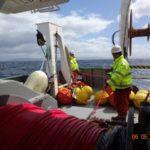NUI Galway Scientists Discover New Deep-Sea Habitats in Irish Waters
Scientists from NUI Galway’s Ryan Institute have published the discovery of novel deep-sea habitats in Irish Waters. Published in the international academic journal PLOS ONE, their findings describe for the first time a rock face half a mile below the sea’s surface.
NUI Galway Zoologist Dr Louise Allcock led the team which explored the Whittard Canyon, an undersea canyon system, using the Irish deep-water remotely operated vehicle, ROV Holland I deployed from the national research vessel, RV Celtic Explorer. The scientists discovered a vertical rock face half a mile below the sea surface, which extended upwards for about 150 metres, and was covered in a rich assemblage of bivalves and corals.
“It is really unusual to see so many conspicuous animals so close together at these depths” explains Mark Johnson, Professor of Marine Environment at NUI Galway. “The bivalves are also remarkably large, and we know that deep-water oysters of this size elsewhere in European Seas may be more than 200 years old. So we are probably seeing an exceptionally long-lived and stable community”.
The bivalves and the corals are filter feeders and are reliant on particles derived from surface waters for their food. The researchers studied the water column to work out how sufficient food might be arriving at the site to support such a large and vibrant community.
NUI Galway oceanographer Dr Martin White said “We were particularly intrigued as to how food particles might be concentrated into one particular area and we found evidence for an internal wave caused by the shape of the canyon, which could be delivering food to the foot of the wall”.
Deep-sea habitats are known to play many important roles in ecosystems, including recycling of nutrients, carbon sequestration and can act as nursery areas for other species, so the scientists are keen to discover more. Remote-operated-vehicles (ROVs) have made many of these habitats accessible for the first time.
Dr Peter Heffernan, Marine Institute said “I congratulate Dr. Louise Allcock and her team at NUI Galway for this great work. The Marine Institute is proud to have supported this work through the provision of essential research infrastructure such as the National Research vessels and the ROV Holland, and funding through the Sea Change programme.”
This deep-sea research is guided by ocean floor mapping around Ireland’s coast (INFOMAR – a joint Marine Institute-GSI initiative) and the knowledge that similar canyon systems around the world are home to the kinds of organisms likely to yield novel pharmaceuticals, an aim of Ireland’s biodiscovery programme.
Dr Allcock says “this habitat, because of its age and fragile structure is potentially extremely vulnerable to damage. We need to establish where else it occurs and what measures are needed to protect it.
The survey was funded under the Sea Change strategy with the support of the Marine Institute and the Marine Research Sub-programme of the National Development Plan 2007–2013.












